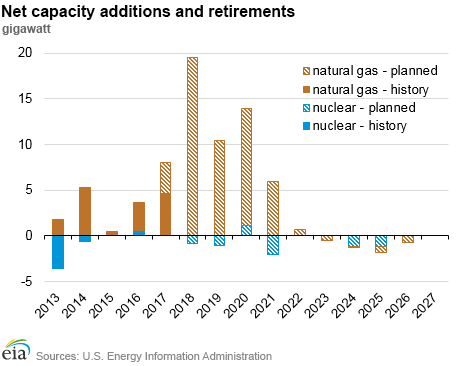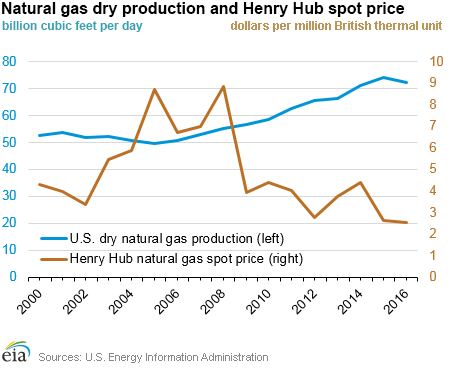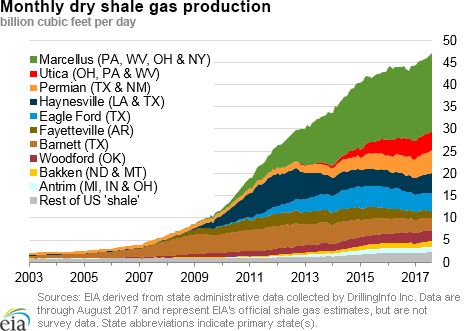Updated November 21 to correct gas-fired power capacity designations.
In the News:
As nuclear power plant retirements increase, natural gas-fired capacity grows
In the past seven years, six nuclear power plants announced their intentions to retire early. The most recent announcement came in May from Exelon’s Three Mile Island power plant in Pennsylvania. These six plants have a current operational capacity of about 7.2 gigawatts (GW). In addition to these plants, construction of South Carolina Electric and Gas Company’s 2.2 GW VC Summer power plant was halted in July. While nuclear capacity is expected to decrease in the next 8 years by 7.2 GW, announced builds at natural gas-fired power plants will offset some of the lost capacity.
As of July 2017, natural gas-fired capacity was slightly more than 40% of total U.S. operating capacity, with the net summer capacity for natural gas-fired plants at about 453 GW. About 54% of the natural gas-fired capacity comes from natural gas combined-cycle (NGCC) plants. Between 2013 and 2017, 25 GW of natural gas-fired capacity retired; many of these generators were steam turbines (about 72% of the capacity retired) and most were older generators with an initial operation year between 1950 and 1980 (87% of the capacity retired). In comparison, nuclear generation net summer capacity totaled 99 GW. Although no nuclear plant retirements occurred between 2002 and 2012, from 2013 to 2017, five plants, with a combined capacity of 4.7 GW were retired. From 2013 to 2016, average net generation for electric power from nuclear energy remained nearly flat, and the generation from natural gas has grown by about 6% per year.
Through 2027, planned natural gas-fired capacity additions total 62 GW for 130 projects. More than three-quarters of the planned capacity are from NGCC plant builds. The two NGCC projects with the largest planned capacity are Citrus County Combined Cycle Plant (1.6 GW) and Okeechobee Clean Energy Center (1.7 GW), both located in Florida. The capital cost estimate for a nuclear power plant is more than six times greater than that of a NGCC plant on a per kilowatt basis. The newest nuclear reactor to enter service, Watts Bar Unit 2 with 1,150 MW net summer electricity generating capacity, began commercial operation in October 2016. Two new nuclear reactors are actively under construction, Vogtle Units 3 and 4 near Augusta, Georgia, which will expand the capacity of the existing nuclear power plant there by 2.2 GW.
Dry natural gas production has increased steadily over the past decade, averaging 72 billion cubic feet per day (Bcf/d) over 2014–2016. During that same time period, the Henry Hub spot price for natural gas averaged $3.17 per million British thermal units (MMBtu) and reached its lowest annual price in seventeen years in 2016 at $2.52/MMBtu. Lower natural gas prices combined with increased electricity generation from natural gas-fired plants contributed to a decrease in electricity prices. In 2016, the national average wholesale price for electricity was about $30 per megawatt hour (MWh), about 17% lower than in the previous year.
Overview:
(For the Week Ending Wednesday, September 27, 2017)
- Natural gas spot prices fell at most locations this report week (Wednesday, September 20 to Wednesday, September 27). The Henry Hub spot price fell from $3.14 per million British thermal units (MMBtu) last Wednesday to $2.95/MMBtu yesterday.
- At the New York Mercantile Exchange (Nymex), the October 2017 contract expired yesterday at $2.974/MMBtu. The November 2017 contract price decreased to $3.061/MMBtu, down 9¢ Wednesday to Wednesday.
- Net injections to working gas totaled 58 billion cubic feet (Bcf) for the week ending September 22. Working natural gas stocks are 3,466 Bcf, which is 4% less than the year-ago level and 1% more than the five-year (2012–16) average for this week.
- The natural gas plant liquids composite price at Mont Belvieu, Texas, rose by 40¢, averaging $8.03/MMBtu for the week ending September 27. The price of natural gasoline, ethane, propane, butane, and isobutane all rose, by 4%, 1%, 7%, 6%, and 5%, respectively.
- According to Baker Hughes, for the week ending Friday, September 22, the natural gas rig count increased by 4 to 190. The number of oil-directed rigs fell by 5 to 744. The total rig count decreased by 1, and it now stands at 935.
Prices/Supply/Demand:
Spot prices fall across the country. This report week (Wednesday, September 20 to Wednesday, September 27), the Henry Hub spot price fell 19¢ from $3.14/MMBtu last Wednesday to $2.95/MMBtu yesterday. At the Chicago Citygate, prices decreased 20¢ from $3.05/MMBtu last Wednesday to $2.85/MMBtu yesterday. Prices at PG&E Citygate in Northern California fell 12¢, down from $3.31/MMBtu last Wednesday to $3.19/MMBtu yesterday. The price at SoCal Citygate decreased 6¢ from $3.04/MMBtu last Wednesday to $2.98/MMBtu yesterday. California locations saw a price increase from Friday to Monday as temperatures increased along the West Coast.
Northeast prices fall. At the Algonquin Citygate, which serves Boston-area consumers, prices went down 78¢ from $2.75/MMBtu last Wednesday to $1.97/MMBtu yesterday. Algonquin prices through the report week varied with temperatures, and prices peaked at $3.35/MMBtu on Monday, when temperatures in New England averaged more than 12 degrees Fahrenheit (°F) above normal. At the Transcontinental Pipeline Zone 6 trading point for New York, prices decreased 38¢ from $3.16/MMBtu last Wednesday to $2.78/MMBtu yesterday. New York did not see the same price trend as Boston; its highest price over the week was on last Wednesday.
Tennessee Zone 4 Marcellus spot prices decreased 47¢ from $1.66/MMBtu last Wednesday to $1.19/MMBtu yesterday. Prices at Dominion South in northwest Pennsylvania fell 59¢ from $1.78/MMBtu last Wednesday to $1.19/MMBtu yesterday.
Negative prices occur in Western Canada. Western Canadian prices were very low, with some negative prices reported Wednesday on TransCanada’s Alberta System, according to Natural Gas Intelligence. These low prices come as increased maintenance on western Canada’s Nova Gas Transmission, Limited (NGTL) pipeline system has had limited flows of uncontracted natural gas over the past two months.
Nymex contracts decrease, October contract expires. At the Nymex, the October 2017 contract expired yesterday at $2.974/MMBtu, down 12¢ from last Wednesday. The November 2017 contract decreased to $3.061/MMBtu, down 9¢ from last Wednesday to yesterday. The price of the 12-month strip averaging November 2017 through October 2018 futures contracts declined 4¢ to $3.077/MMBtu.
Supply remains flat. The average total supply of natural gas remained the same as the previous report week, 80.1 Bcf/d, according to data from PointLogic Energy. Dry natural gas production remained constant week over week. Overall, average net imports from Canada increased by 1% from last week, but from Monday to yesterday, net imports decreased by 0.9 Bcf/d.
Demand rises. Total U.S. consumption of natural gas rose by 6% compared with the previous report week, according to data from PointLogic Energy. This increase in consumption was driven by an increase in both heating and cooling demand, as the eastern and western halves of the country experienced contrasting weather patterns. Natural gas consumed for power generation climbed by 9% week over week as temperatures in the eastern half of the country rose further above seasonal norms to as much as 16°F above normal in some places.
In contrast, the western half of the country had cooler temperatures than in the previous week. In some places, temperatures were 10°F below seasonal norms, which led to an increase of 11% in consumption in the residential and commercial sectors. Industrial sector consumption stayed constant, averaging 19.4 Bcf/d. Natural gas exports to Mexico increased 4%.
U.S. liquefied natural gas (LNG) exports remain flat. Five vessels (LNG-carrying capacity 18.5 Bcf) departed Sabine Pass liquefaction terminal last week (Thursday to Wednesday) and one vessel (LNG-carrying capacity 3.8 Bcf) was loading at the terminal on Wednesday. The terminal operator, Cheniere, requested approval by the Federal Energy Regulatory Commission (FERC) to place the fourth liquefaction train at Sabine Pass into service.
LNG imports to Puerto Rico are suspended. As a result of Hurricanes Irma and Maria, LNG imports to Puerto Rico have been temporarily suspended. Puerto Rico imports LNG primarily to supply a power plant, Costa Sur, operated by the Puerto Rico Electric Power Authority (PREPA) and located in close proximity to the LNG regasification terminal Peñuelas. Typically, Puerto Rico imports two to three LNG cargoes per month (3 Bcf–6 Bcf net imports). So far in September, Puerto Rico received one LNG shipment on September 8. A second shipment left Trinidad on September 12 for a typical two- to three-day voyage but had to wait out the hurricanes for more than two weeks. The ship then was unable to unload at the terminal and was diverted away to deliver this shipment to Brazil.
Puerto Rico’s only regasification facility, Peñuelas, is located at Guayanilla Bay and operated by EcoEléctrica LP. In August 2017, FERC approved the expansion of Peñuelas regasification capacity from 186 million cubic feet per day (MMcf/d) to 279 MMcf/d. Once the expansion is complete, 186 MMcf/d of regasified LNG will be supplied to the Costa Sur power plant. The remaining 93 MMcf/d will be supplied to EcoEléctrica’s cogeneration plant. The expanded regasification capacity will allow imports of about 40 LNG cargoes per year compared with 27-28 LNG cargoes imported in 2015–16.
Puerto Rico generates about half of its electricity using petroleum; about one-third using natural gas and coal (evenly divided); and 2.4% using renewable energy sources, including wind, solar, and hydro. Initial post-storm assessments show significant damage to transmission and distribution systems. Depending on the conditions at Costa Sur, LNG shipments to Peñuelas will likely be suspended until the power plant and transmission lines are back in service.
Through the end of September 2017, Puerto Rico has imported 15 LNG cargoes, all from Trinidad and Tobago. In previous years, during periods of high demand, LNG imports from Trinidad and Tobago were supplemented with spot purchases from other countries, including Norway, Nigeria, Equatorial Guinea, and re-exports from Belgium, the United Kingdom, and Spain.
Storage:
Net injections fall below the five-year average with gains in electric power consumption. Net injections into storage totaled 58 Bcf for the week ending September 22, compared with the five-year (2012–16) average net injections of 84 Bcf and last year's net injections of 49 Bcf during the same week. Increased power demand for natural gas likely contributed to lower net injections compared with the previous report week, despite increased natural gas production. Net injections into storage were lower than the five-year average in all regions east of the Rockies, with the South Central region 19 Bcf lower than the five-year average. Working gas stocks total 3,466 Bcf, which is 41 Bcf more than the five-year average and 127 Bcf less than last year at this time.
Working gas stocks poised to end the refill season near 3,900 Bcf. So far during the 2017 refill season, net injections into storage are 14% lower than the comparable five-year average—1,415 Bcf during the 2017 refill season compared with the five-year average increase of 1,639 Bcf. If net injections continue to be 14% lower than the five-year average going forward, then working gas stocks will reach 3,826 Bcf by the end of the refill season. However, working gas stocks will total 3,883 Bcf if net injections into working gas match the five-year average for the remainder of the refill season.
The January 2018 futures price continues trading at a premium over the current spot price. During the most recent storage week, the average natural gas spot price at the Henry Hub was $3.10/MMBtu, while the Nymex futures price of natural gas for delivery in January 2018 averaged $3.37/MMBtu, a premium of 27¢. The premium was 35¢ a year ago. The average natural gas spot price at the Henry Hub was 3¢ higher than the front-month futures price at the Nymex. A year ago, the spot price was 4¢ higher than the front-month contract.
The reported net implied flows into storage are on the low side of analysts’ expectations. According to the Desk survey of natural gas analysts, estimates of net injections to working natural gas storage ranged from 56 Bcf to 73 Bcf with a median of 65 Bcf. Prices on the futures contract for October delivery rose about 3¢/MMBtu to $3.07/MMBtu with 694 contracts traded at the release of the Weekly Natural Gas Storage Report (WNGSR). Prices remained close to this level in subsequent trading.
Temperatures are higher than normal in most of the Lower 48 states east of the Rockies. Temperatures in the Lower 48 states averaged 72°F, 5°F higher than the normal and 1°F lower than last year at this time. Temperatures west of the Rockies were generally cooler than normal. Temperatures in the Mountain Census division averaged 64°F, 1°F lower than the normal and 4°F lower than last year at this time. Temperatures in the Pacific Census division also averaged 64°F, 3°F lower than the normal and 6°F lower than last year at this time.
See also:
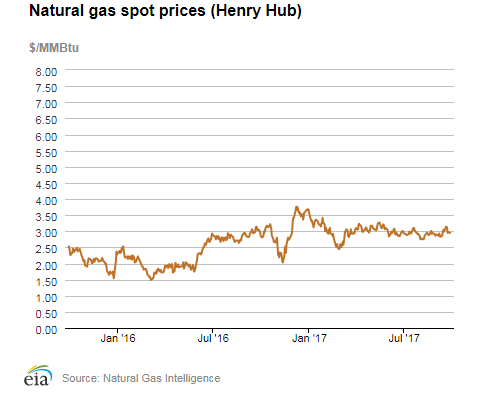
| Spot Prices ($/MMBtu) | Thu, 21-Sep |
Fri, 22-Sep |
Mon, 25-Sep |
Tue, 26-Sep |
Wed, 27-Sep |
|---|---|---|---|---|---|
| Henry Hub |
3.11 |
2.95 |
2.97 |
2.95 |
2.95 |
| New York |
2.99 |
3.01 |
3.04 |
2.94 |
2.78 |
| Chicago |
2.96 |
2.89 |
2.95 |
2.88 |
2.85 |
| Cal. Comp. Avg.* |
2.85 |
2.75 |
2.85 |
2.79 |
2.78 |
| Futures ($/MMBtu) | |||||
| October Contract | 2.946 |
2.959 |
2.919 |
2.918 |
2.974 |
| November Contract |
3.007 |
3.021 |
2.988 |
3.000 |
3.061 |
| *Avg. of NGI's reported prices for: Malin, PG&E Citygate, and Southern California Border Avg. | |||||
| Source: NGI's Daily Gas Price Index | |||||
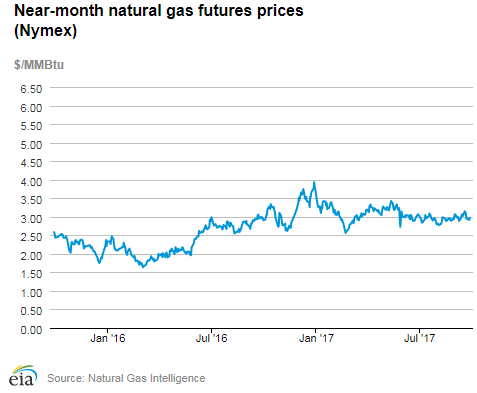
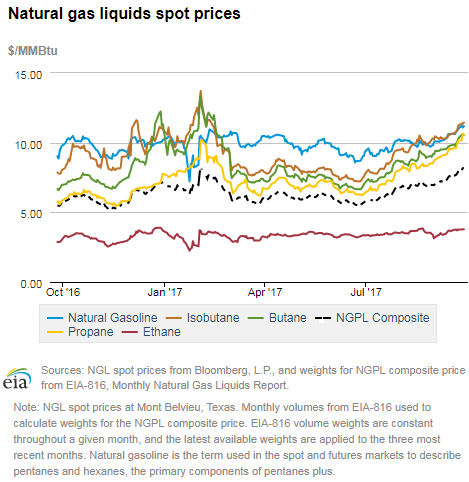
| U.S. natural gas supply - Gas Week: (9/21/17 - 9/27/17) | |||
|---|---|---|---|
Average daily values (Bcf/d): |
|||
this week |
last week |
last year |
|
| Marketed production | 83.5 |
83.8 |
78.3 |
| Dry production | 74.3 |
74.5 |
69.9 |
| Net Canada imports | 5.7 |
5.6 |
6.0 |
| LNG pipeline deliveries | 0.1 |
0.0 |
0.1 |
| Total supply | 80.1 |
80.2 |
75.9 |
|
Source: OPIS PointLogic Energy, an IHS Company | |||
| U.S. natural gas consumption - Gas Week: (9/21/17 - 9/27/17) | |||
|---|---|---|---|
Average daily values (Bcf/d): |
|||
this week |
last week |
last year |
|
| U.S. consumption | 61.4 |
58.0 |
56.5 |
| Power | 33.8 |
31.2 |
30.9 |
| Industrial | 19.4 |
19.5 |
19.3 |
| Residential/commercial | 8.1 |
7.3 |
6.3 |
| Mexico exports | 4.2 |
4.0 |
4.1 |
| Pipeline fuel use/losses | 6.8 |
6.4 |
6.3 |
| LNG pipeline receipts | 2.2 |
2.8 |
0.0 |
| Total demand | 74.6 |
71.2 |
66.9 |
|
Source: OPIS PointLogic Energy, an IHS Company | |||
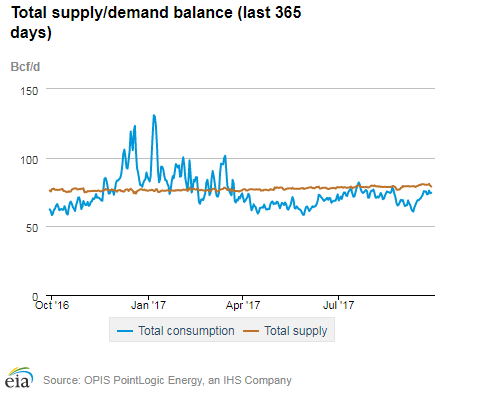
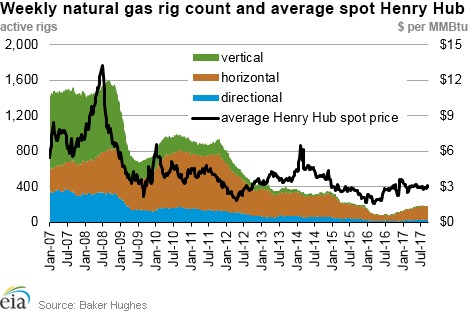
| Rigs | |||
|---|---|---|---|
Fri, September 22, 2017 |
Change from |
||
last week |
last year |
||
| Oil rigs | 744 |
-0.7% |
78.0% |
| Natural gas rigs | 190 |
2.2% |
106.5% |
| Note: Excludes any miscellaneous rigs | |||
| Rig numbers by type | |||
|---|---|---|---|
Fri, September 22, 2017 |
Change from |
||
last week |
last year |
||
| Vertical | 68 |
1.5% |
13.3% |
| Horizontal | 790 |
-0.6% |
96.5% |
| Directional | 77 |
4.1% |
57.1% |
| Source: Baker Hughes Inc. | |||
| Working gas in underground storage | ||||
|---|---|---|---|---|
Stocks billion cubic feet (Bcf) |
||||
| Region | 2017-09-22 |
2017-09-15 |
change |
|
| East | 848 |
833 |
15 |
|
| Midwest | 964 |
938 |
26 |
|
| Mountain | 217 |
212 |
5 |
|
| Pacific | 307 |
300 |
7 |
|
| South Central | 1,130 |
1,125 |
5 |
|
| Total | 3,466 |
3,408 |
58 |
|
| Source: U.S. Energy Information Administration | ||||
| Working gas in underground storage | |||||
|---|---|---|---|---|---|
Historical comparisons |
|||||
Year ago (9/22/16) |
5-year average (2012-2016) |
||||
| Region | Stocks (Bcf) |
% change |
Stocks (Bcf) |
% change |
|
| East | 871 |
-2.6 |
837 |
1.3 |
|
| Midwest | 1,010 |
-4.6 |
958 |
0.6 |
|
| Mountain | 233 |
-6.9 |
202 |
7.4 |
|
| Pacific | 318 |
-3.5 |
339 |
-9.4 |
|
| South Central | 1,162 |
-2.8 |
1,090 |
3.7 |
|
| Total | 3,593 |
-3.5 |
3,425 |
1.2 |
|
| Source: U.S. Energy Information Administration | |||||
| Temperature – heating & cooling degree days (week ending Sep 21) | ||||||||
|---|---|---|---|---|---|---|---|---|
HDD deviation from: |
CDD deviation from: |
|||||||
| Region | HDD Current |
normal |
last year |
CDD Current |
normal |
last year |
||
| New England | 2 |
-34 |
-2 |
30 |
28 |
0 |
||
| Middle Atlantic | 1 |
-26 |
-1 |
42 |
32 |
9 |
||
| E N Central | 3 |
-27 |
0 |
46 |
35 |
8 |
||
| W N Central | 14 |
-21 |
3 |
44 |
28 |
5 |
||
| South Atlantic | 0 |
-8 |
0 |
78 |
21 |
-15 |
||
| E S Central | 0 |
-8 |
0 |
73 |
28 |
-19 |
||
| W S Central | 0 |
-2 |
0 |
113 |
37 |
-5 |
||
| Mountain | 36 |
-3 |
17 |
32 |
-4 |
-9 |
||
| Pacific | 13 |
1 |
9 |
6 |
-23 |
-32 |
||
| United States | 7 |
-15 |
3 |
53 |
20 |
-7 |
||
|
Note: HDD = heating degree day; CDD = cooling degree day Source: National Oceanic and Atmospheric Administration | ||||||||
Average temperature (°F)
7-Day Mean ending Sep 21, 2017
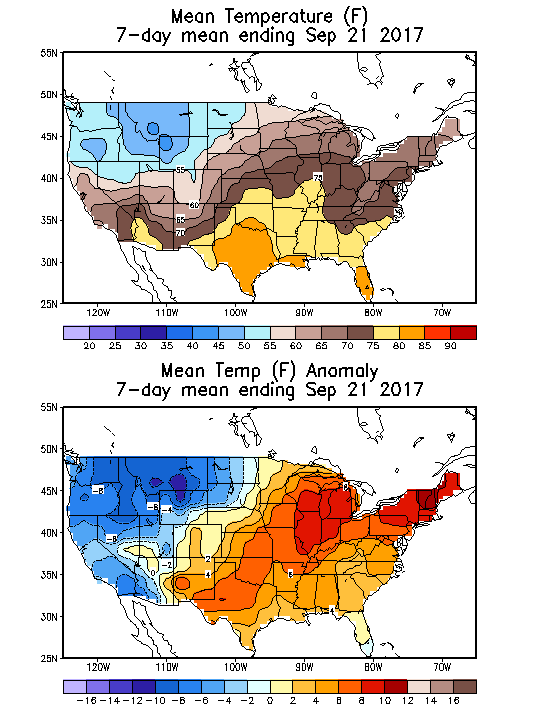
Source: NOAA National Weather Service
Deviation between average and normal (°F)
7-Day Mean ending Sep 21, 2017

Source: NOAA National Weather Service

